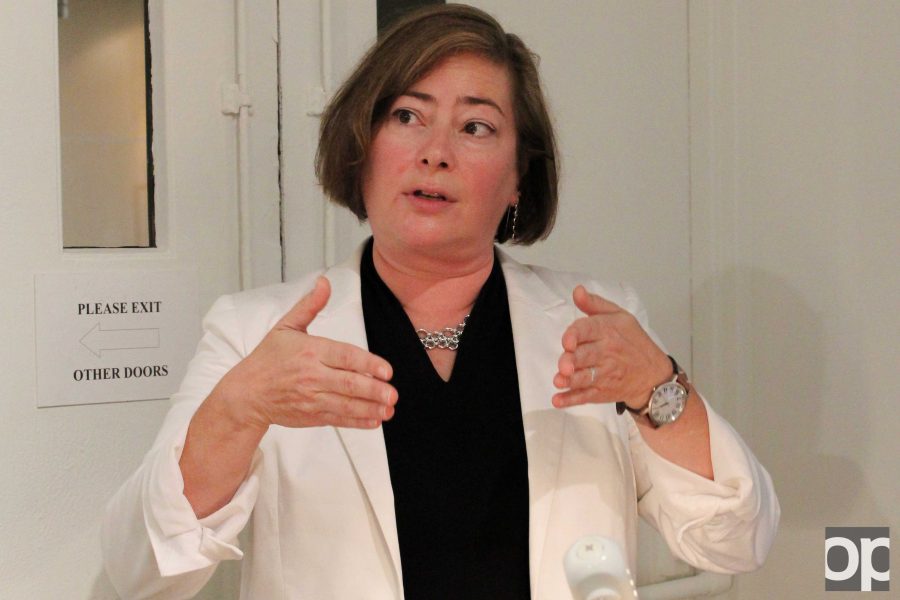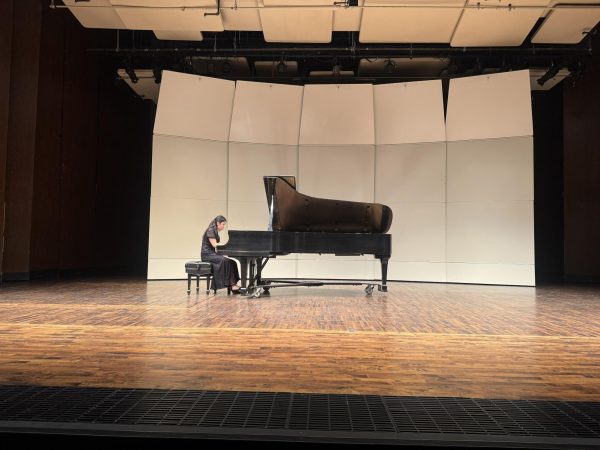Lecture puts new spin on Japanese art
Dr. Gennifer Weisenfeld, professor at the Duke Trinity College of Arts and Sciences gives a speech at Oakland University Thursday, Sept. 29.
A lecture featuring Dr. Gennifer Weisenfeld was held on Sept. 29 at 12 p.m. in the Wilson Hall art gallery.
She is a professor at the Duke Trinity College of Arts and Sciences, and her research focuses on modern and contemporary Japanese design, art history, and visual culture, according to school’s website.
Titled “Transwar Design,” the lecture discussed the ways in which design helped to rebuild Japan after World War II.
Although the war is long over, Weisenfeld said there is still a taboo surrounding the discussion of these times, which has done damage to Japan’s design history.
Therefore, she proposed to think about this time period using the model of Transwar design. This is a framework that reclaims the often ignored importance of these design practices.
“Understanding these continuities goes a long way in helping us understand and explain Japan’s post-war economic miracle,” Weisenfeld said.
Despite much devastation, the country was still able to recover.
Weisenfeld specifically examined the career of Kamekura Yusaku, one of the earliest art directors in Japan. She displayed many of his works, which were often bold and experimental.
Although these pieces were used as propaganda for the state during the war, they look far different from what one would normally imagine.
Weisenfeld made it clear that the wartime period wasn’t a gap in which designers remained stagnant. Contrary, a lot of work was done to help set up the country after the war.
Another major point of discussion was the 1964 Tokyo Olympics, the first hosted by an Asian country.
The logos and advertisements captured Japan’s style—modern and well-organized, yet rooted in tradition. Design helped to establish its position, putting the country back on the map.
“The publicity mechanisms that transitioned from the consumer advertising in inter-war years into the marketization and empire through the 1930s and 1940s were absolutely essential building blocks for post-war reconstruction,” Weisenfeld said.
Meaghan Barry, assistant professor of graphic design, chose Dr. Weisenfeld to speak after they both participated in the 2016 Design Incubation Fellowship this January.
“Through the fellowship, I was so impressed with Dr. Weisenfeld’s research and knew I had to get her to Oakland University,” said Barry.
The lecture was held through a grant by the Judd Family Endowed Fund, which gives Oakland University and the College of Arts and Sciences the chance to support programs in the humanities and arts, according to Donor Relations and Events Coordinator Lori Posey.
The event was also supported by the Art and Art History Department in the College of Arts and Sciences, as well as the OU Art Gallery.
Barry said that some of Dr. Weisenfeld’s work has only been accessed by her.
“Having the opportunity to access specialized research like Dr. Weisenfeld’s is a great gift provided by the Judd family,” said Barry.
Barry said that Weisenfeld’s research is not only highly specialized, but also cross-disciplinary. Because of this, Barry believes this lecture might help to inspire many people in different majors.
“Her research reminds our students and our community that research is not exclusive to any one discipline, and I hope will inspire more interdisciplinary work on campus,” said Barry.
In wrapping up the event, Weisenfeld was asked what inspired her to research the field of Japanese design. She mentioned the quality of the work and how prevalent it is in daily life. Then, she simply concluded:
“Design mediates everything we do.”





